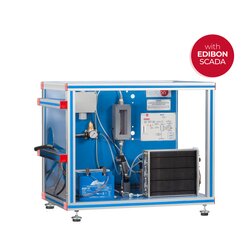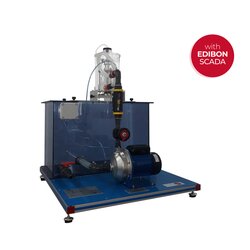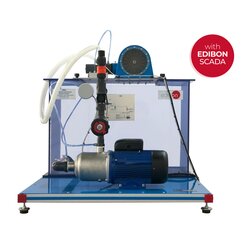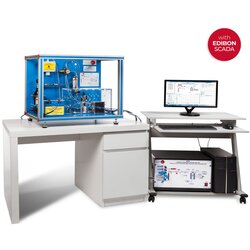Computer Controlled Bioethanol Process Unit (EBEC)
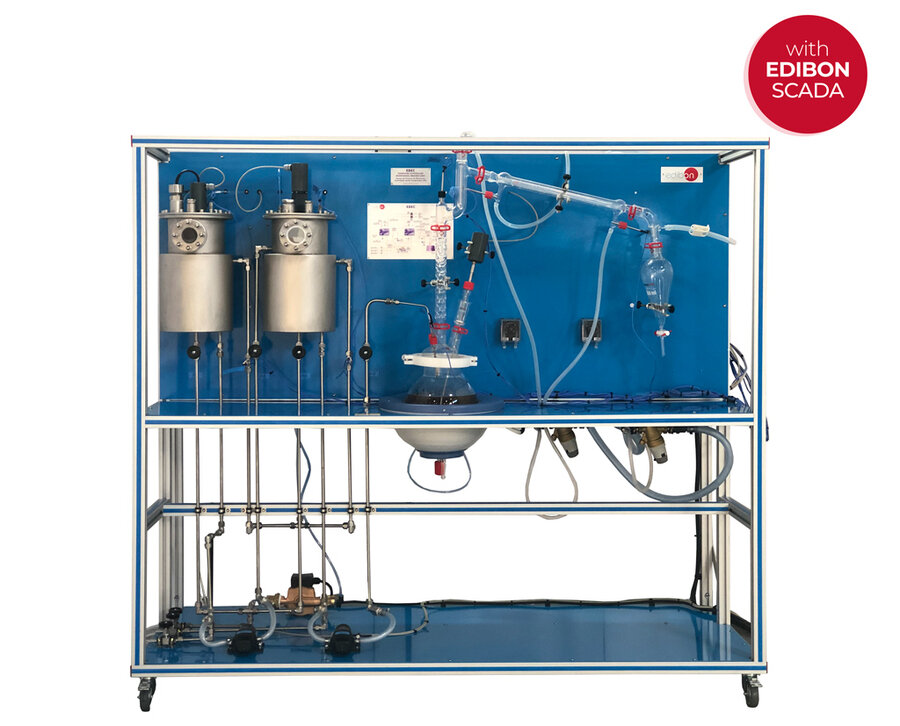


PL-112452
The Computer Controlled Bioethanol Process Unit, "EBEC," is designed to facilitate a detailed exploration and control of bioethanol production at a laboratory scale. This unit allows users to thoroughly monitor each critical stage, from the conversion of starches into fermentable sugars to ethanol production and final distillation.
The system consists of three primary components: the mash tank, fermentation tank, and distillation unit. Contact surfaces within these components (excluding the distillation unit) are made of stainless steel, while borosilicate glass and Neoceram glass sight windows are used in the distillation unit for high-temperature resilience and visibility.
The mash tank includes an upper inlet for adding water, starch, and enzymes. Its slightly angled bottom facilitates efficient drainage and transfer of the mash to the fermentation tank. The initial liquefaction of starch is catalyzed by the enzyme alpha-amylase, followed by saccharification with glucoamylase to yield glucose. This tank is equipped with sensors for temperature and pH monitoring, with pH adjustments made via an acid/base circuit.
Once saccharification is complete, the mash moves to the fermentation tank, which also features an angled base for easy transfer to the distillation unit. Here, yeast initiates fermentation, producing ethanol and CO2. A temperature sensor continuously tracks conditions within the fermentation mixture.
Both tanks are equipped with jackets for indirect heating through a hot water system and are continually stirred. Transparent sight glasses permit visual monitoring of the process. Temperature within these tanks is controlled by a PID system, which utilizes dual temperature sensors at the jacket outlet to ensure precise temperature maintenance.
The hot water system, including a thermostatic bath and pump, provides consistent thermal regulation across the tanks, with an additional temperature sensor within the bath for accuracy.
After fermentation, the resulting mixture is sent to the distillation unit. This unit includes a heating mantle, an agitator, a distillation column, a dephlegmator (cold finger), a condenser, and a decanting funnel, with four temperature sensors strategically positioned for precise monitoring.
The EBEC is equipped with the EDIBON Computer Control System (SCADA), which comprises the main unit, a control interface box, a data acquisition board, and specialized software for monitoring, data collection, and management of process parameters. This system enables detailed observation and control over all stages of the bioethanol production process.
- EBEC. Unit:
- Anodized aluminum frame and panels made of painted steel.
- The unit includes wheels to facilitate its mobility.
- Main metallic elements made of stainless steel.
- Diagram in the front panel with distribution of the elements similar to the real one.
- All the vessels, valves and other accessories in contact with process materials (except the distillation unit) are made of stainless steel. The distillation unit is made of borosilicate glass. Sight glasses are made of Neoceram glass.
The “EBEC” unit mainly consists of:
- Mash tank.
- Fermentation tank.
- Distillation unit.
- Two computer controlled diaphragm pumps to introduce the solution into the fermentation tank and the distillation unit.
- Temperature sensors.
- pH sensor measures the pH of the mash inside the mash tank.
- Hot water circulation system.
- Acid/base circuit system.
- Seven valves
The complete unit includes as well:
- Advanced Real-Time SCADA.
- Open Control + Multicontrol + Real-Time Control.
- Specialized EDIBON Control Software based on LabVIEW.
- National Instruments Data Acquisition board.
- Calibration exercises, which are included, teach the user how to calibrate a sensor and the importance of checking the accuracy of the sensors before taking measurements.
- Projector and/or electronic whiteboard compatibility allows the unit to be explained and demonstrated to an entire class at one time.
- Capable of doing applied research, real industrial simulation, training courses, etc.
- Remote operation and control by the user and remote control for EDIBON technical support, are always included.
- Totally safe, utilizing 4 safety systems (Mechanical, Electrical, Electronic and Software).
- Designed and manufactured under several quality standards.
- Optional ICAI software to create, edit and carry out practical exercises, tests, exams, calculations, etc. Apart from monitoring user’s knowledge and progress reached.
- This unit has been designed for future expansion and integration. A common expansion is the EDIBON Scada-Net (ESN) System which enables multiple students to simultaneously operate many units in a network.
- EBEC/CIB. Control Interface Box.
- EBEC/CCSOF. PID Computer Control + Data Acquisition + Data Management Software
- Cables and Accessories, for normal operation.
- Manuals: This unit is supplied with 8 manuals: Required services, Assembly and Installation, Interface and Control software, Starting-up, Safety, Maintenance, Calibration and Practices manuals.
EXERCISES AND PRACTICAL POSSIBILITIES TO BE DONE WITH THE MAIN ITEMS
- Familiarization with the individual steps required for bioethanol production.
- Familiarization with the plant components required for bioethanol production.
- Study of the effect of temperature on bioethanol purity.
- Study of the effect of pH on bioethanol yield.
- Study of the effect of mashing time on bioethanol yield.
- Study of the effect of fermentation time on bioethanol yield.
- Study of the use of different raw materials to produce bioethanol.
- Study of the effect of adding different types of yeast to the fermentation.
What is this?
These percentage scores are an average of 0 user reviews. To get more into detail, see each review and comments as per below
If you have used this product, support the community by submitting your review
